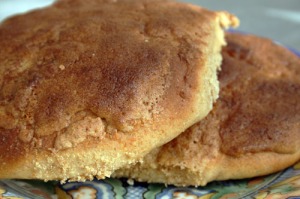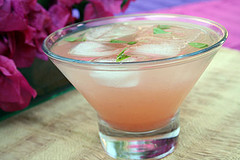Cinnamon Spelt Conchas
Pan dulce, or “sweet bread”, is an important part of the Mexican diet. Every supermarket has a large section dedicated to the bakery, where they sell the standard bolillos and teleras, as well as the myriad of sweet breads in all of their shapes, sizes and degrees of sweetness. Whenever I go to Mexico I spend so much time eying the pan dulce display and choosing which one I will have for that night’s merienda or the next morning’s breakfast.
My favorite type of Mexican pan dulce is the concha. In Mexican Spanish concha means shell, and the design of the sugary topping of the bread is suggestive of its namesake. In college this created some confusion among my friends from the Cono Sur, who thought that an invitation to eat conchas at my apartment was something quite different and perhaps inappropriate.
I have made conchas from scratch before. They are sweet breads capped with a topping made of flour, butter, sugar, and flavoring. In Mexico you can buy them fresh at the bakery daily, but here in the United States they usually come pre-packaged and a bit stale. Somehow here they can also be every color in the rainbow. In Mexico they are only brown (chocolate) or white (vanilla). Emma, my partner in crime, can vouch for just how good fresh conchas can be. While we were in Valle de Bravo with my aunt Lupita and Tita filming for our Comida en el Campo episode for Kitchen Caravan we were spoiled with crispy and airy conchas from the local baker. We topped them with fresh nata, the Mexican version of clotted cream. I digress.

Cinnamon Spelt Conchas
The recipe I have for conchas is from The Complete Book of Mexican Cooking by Elisabeth Lambert Ortiz. The first time I made them I was surprised that the topping was flavored with cinnamon, as opposed to the standard chocolate or vanilla mentioned above. For some reason, the cinnamon gave it a much homier feel, and it has since replaced vanilla as my favorite topping. In the past I have stuck to the original recipe, but this time I thought I would try and use 100% spelt flour. I had a bag of local spelt flour from Wild Hive Farm in Clinton Corners, New York. My spelt conchas were much denser than regular ones. I would prefer to call them “rustic”. I added a bit of lemon oil to the cinnamon topping, just enough to give it a subtle aroma. Even though my mom complained of their “rusticity”, I caught her nibbling away any chance she had. My father also siphoned off piece after piece, so after only 1 day I had only 2 whole ones left to photograph. I am upset about the “lattice” topping, which for me turned into somewhat of a globby mess. Oh well, there is always a next time, and I am happy to learn from my mistakes. The use of spelt flour was not one of them, but I hope to perfect my little buns in other ways.
Dough Ingredients:
1 package active dry yeast
½ lukewarm water
1 teaspoon salt
½ cup sugar
¾ cup milk or soy milk
1 egg, well beaten
3 ½ cups sifted spelt flour
2 tablespoons butter, melted
Topping:
½ stick butter, softened
½ cup sugar
¼ teaspoon salt
1 teaspoon cinnamon
1 egg
½ cup sifted spelt flour
¼ teaspoon lemon oil
Mix together the warm water and yeast. Stir in the salt and sugar, and let stand 5 minutes. Heat the milk in a small saucepan until steam rises from the top.
Cool and combine with the yeast mixture. Stir in the egg. Gradually stir in half of the flour and mix until combined. Add the melted butter, then the remaining flour. Cover and allow to rest in a warm place until it has doubled size, about 1 hour.
Meanwhile, make the topping by creaming the butter and sugar until light and fluffy. Add the salt and cinnamon and mix. Add the egg and flour and stir until everything is thoroughly blended.
Turn onto a lightly floured board, divide into 6 pieces and form into round buns. Spread the topping on. Make a decorative design with a knife. You can buy special stamps in Mexico for this very purpose. Place the buns on a greased baking sheet, cover, and let rise for another hour. Bake in a 400º F oven for 15 minutes. Makes 6 conchas with some leftover dough for minis.
I like to slice them in half horizontally and toast both sides. I then spread with jam and dip in my cafe con leche. You can also dip them whole.
